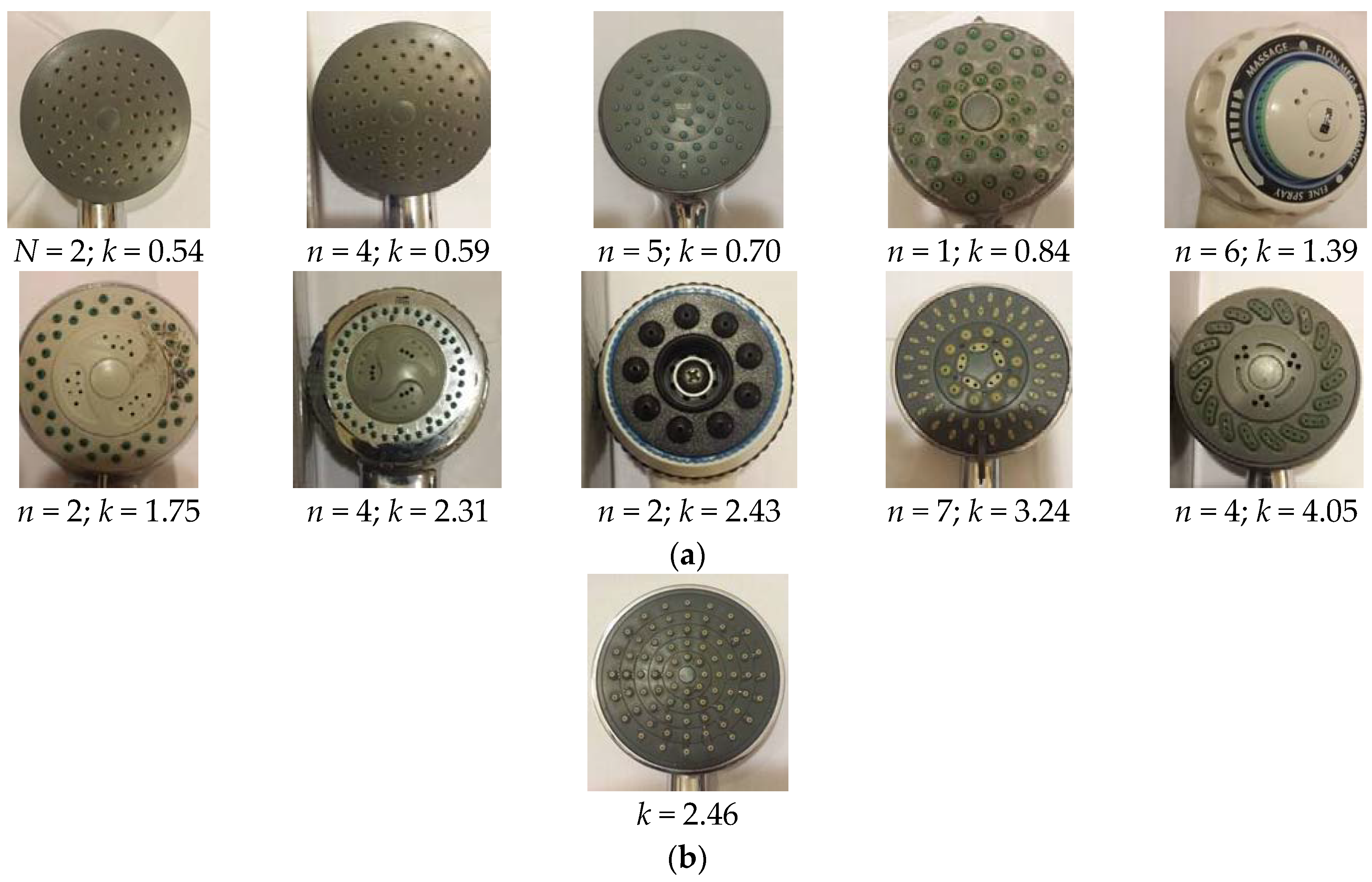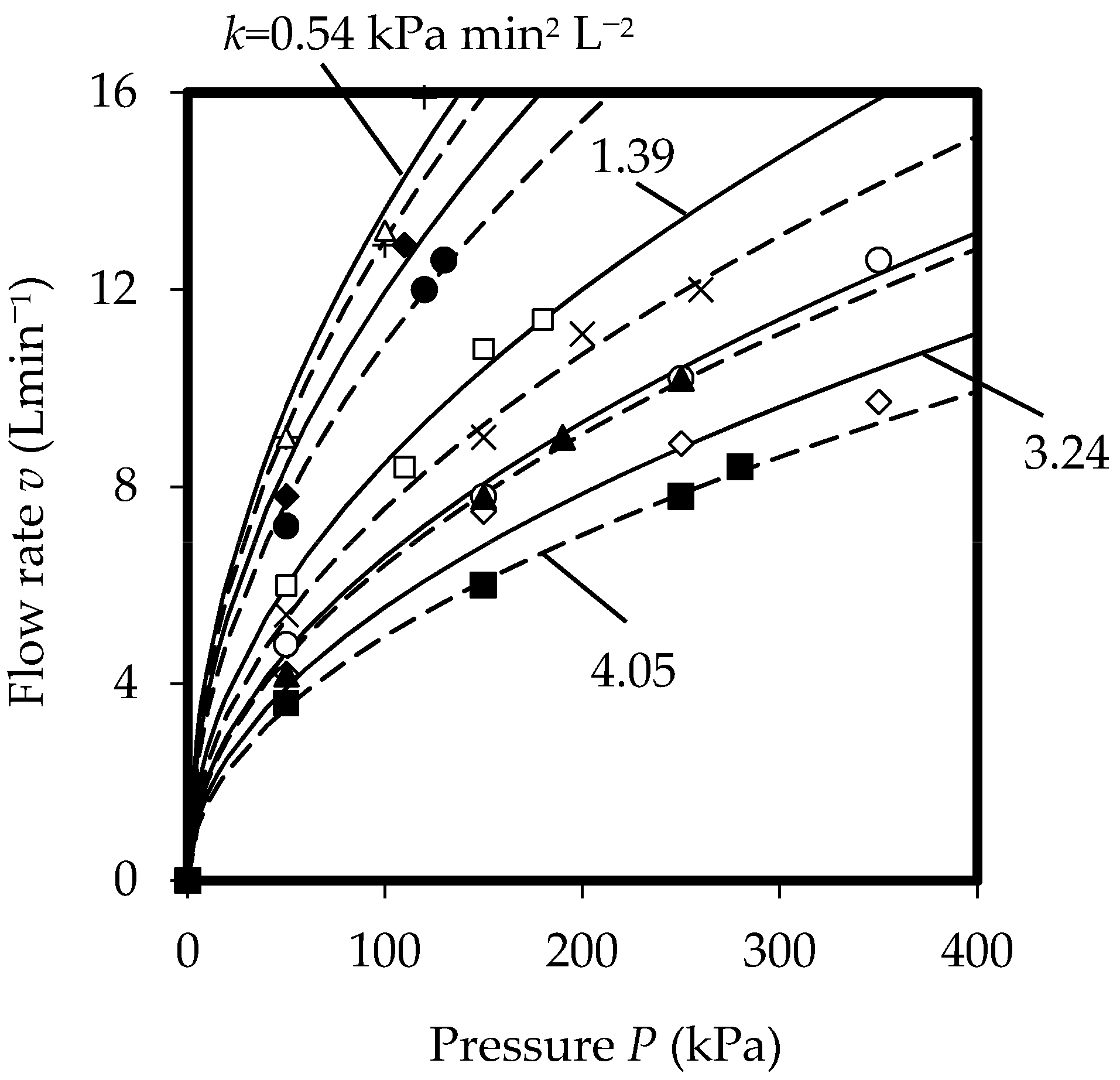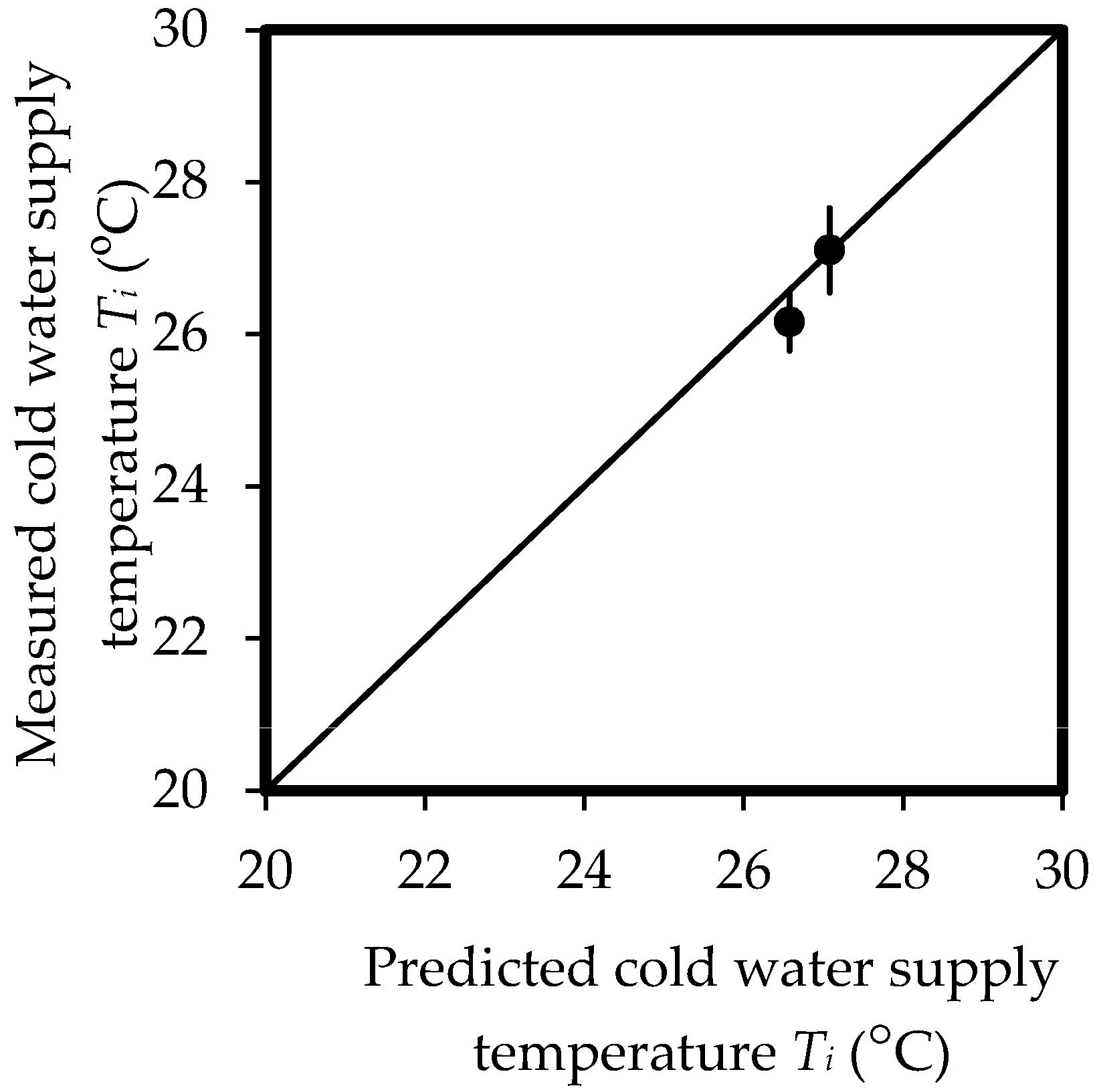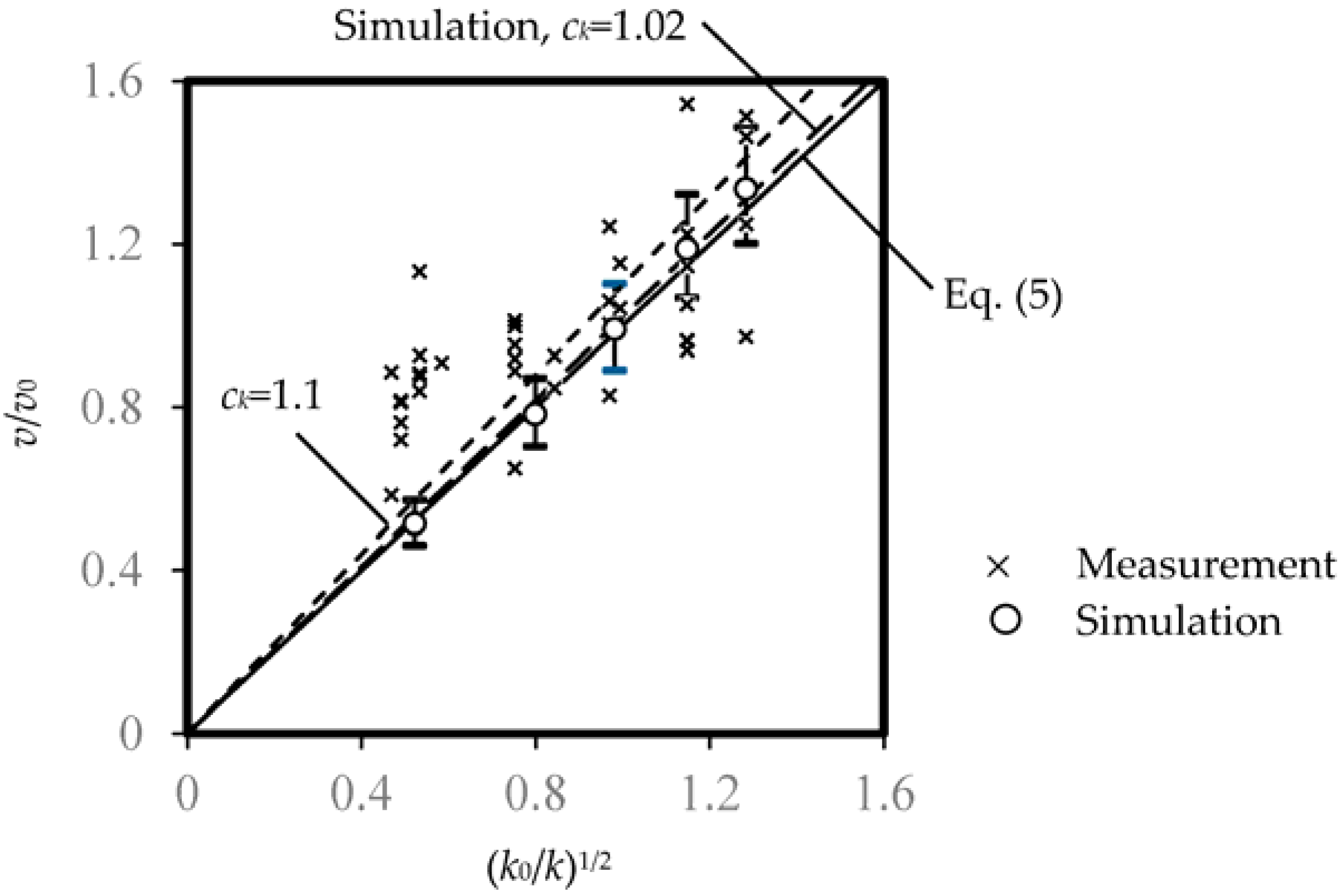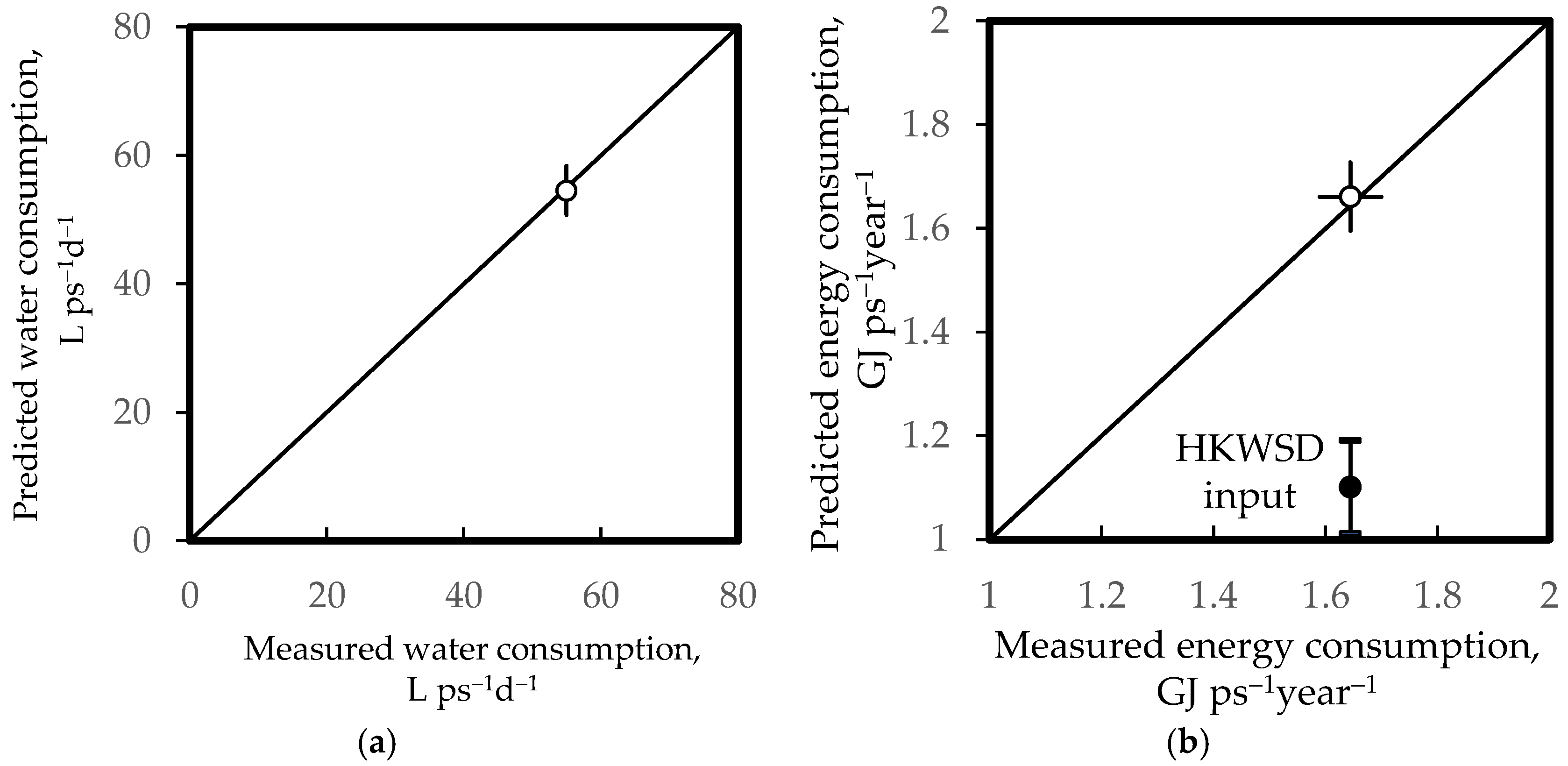This study recorded a wide range of non-WELS showerhead designs and their hole configurations are illustrated in
Figure 1a. Some of these designs were flow rate adjustable to optimize user satisfaction. Although an earlier survey indicated that 98.8% households supported water conservation measures and 36.4% of them were aware of WELS [
4,
6], this study revealed that the usage rate of WELS rated showerheads was not high and further promotion for these showerheads may be required. This study also reported that 32 participants preferred a fine mist spray while five preferred a powerful spray. Regarding showerhead performance, five participants (13.5%) were not satisfied with their existing showerheads but kept using them.
Table 1 summarizes the surveyed showering attributes. Thirty-four participants (92%) expressed that they were willing to have hot showers even in the summer period. This is consistent with a previous survey that found 97% of the summer showers were hot ones [
11]. The hot shower temperature (
T0) preferred was between 37 and 39 °C, with an average of 38.6 °C (SD = 2.5 °C). The average showerhead operating time (
ts) surveyed was 282 s, with SD = 108 s. In the interviews, 28 participants (76%) reported that they would shampoo every day, eight (22%) every other day and one once every six days. The showerhead operating time for shampooing ranged from 2 to 6 min (average = 2.9 min), and 24 participants (65%) usually took 2 min for shampooing. The expected daily showerhead operating time for shampooing was about 151 s (i.e., average time weighted by the shampooing frequency). The total mean showerhead operating time was 433 s (= 282 s + 151 s), and that was not significantly different from the HKWSD reference value (= 402 s) [
6]. During the survey period, all participants took one shower daily (1 day
−1). This is again consistent with some previous survey results in Hong Kong: 1.04 times per day between mid-September and mid-January [
6] and 1.1 times per day (SD = 0.3 times per day) from December to February [
11].
The average hot shower temperature and showerhead operating time measured were 38.5 °C (SD = 2 °C) and 305 s (SD = 107 s), respectively; there was no significant difference between them and the values surveyed from the interviews (p ≥ 0.4, t-test).
3.1. Showerhead Resistance Factor and Showering Attributes
Figure 2 shows the flow rate
v (L·min
−1) against water supply pressure
P (kPa) for the 10 showerheads surveyed.
The operating parameters of the 10 surveyed showerheads, with showerhead resistance factors
k, were monitored for a week (the average outdoor temperature in that week was 26.3 °C) and the findings are presented in
Table 2. The measured hot shower temperature
T0, ranging from 36.8 °C to 42.7 °C, is not only comparable to the average hot shower temperatures reported in Japan (39 °C) and Taiwan (36.1 °C), but is also consistent with a previous local measurement result (40.9 °C) [
11,
12]. The average showerhead operating time ranged from 240 s to 359 s.
Figure 3 graphs the predicted and measured cold water supply temperatures for the showerheads surveyed as a confirmation to an expression below obtained for Hong Kong residential apartment buildings. A reference line indicating perfect prediction with measurement is shown in the figure. The following expression of cold water supply temperature
Ti was confirmed for washrooms in high-rise residential buildings in Hong Kong [
11]. Good predictions were made as shown in the figure.
Strong associations with showerhead resistance factor
k were reported for hot shower temperature
T0 (
p < 0.001,
t-test), temperature difference between hot and cold water supply
T0 −
Ti (
p < 0.0001,
t-test), flow rate
v (
p = 0.05,
t-test) and water consumption
V (
p = 0.05,
t-test), but not for shower duration
t (
p = 0.4,
t-test). A higher shower temperature was observed for showerheads with lower flow rates (
p = 0.05,
t-test). This is consistent with an earlier laboratory study that showed lower flow showerheads, which resulted in increased shower temperatures for maintaining user comfort [
13].
Measurements of four operating parameters, namely hot shower temperature
T0, flow rate
v, shower duration
t and water consumption
V, were then continued for five months with the replaced WELS showerheads (
k = 2.46) (
Figure 1b) and the results are exhibited in
Table 3.
Shower duration was demonstrated to be independent of the showerhead design (
p = 0.4,
t-test). An earlier study reported a similar outcome [
14]. On the other hand, water consumption was apparently reduced in the first month after higher flow showerheads (
k < 2.46) had been replaced by a lower flow one (
k = 2.46); therefore, the use of WELS rated showerheads can improve water efficiency [
4].
It was found that outdoor temperature
Ta dropped significantly from the first two months (21.7–23.7 °C) to the last three months (15.8–16.3 °C) (
p < 0.0001,
t-test). No significant difference between these two periods was found for shower temperature
T0 (
p > 0.05,
t-test), flow rate
v (
p > 0.05,
t-test) and water consumption
V (
p > 0.05,
t-test). However, significantly longer shower durations were reported for Groups 1, 3 and 5 (
p ≤ 0.05,
t-test). The shower duration increased from 297 s to 327 s (i.e., for an outdoor temperature drop of 6 °C, the shower duration was 10% longer) in the two periods. A plot of shower duration
t against outdoor temperature
Ta suggested a strong association (correlation coefficient R = 0.7,
p = 0.001,
t-test). Shower operating time is one of the dominating factors of heating energy use for hot water and it may be related to a number of factors such as human thermal comfort and behavior response to climate. Hence, the expected showerhead operating time against the outdoor temperature can be expressed as follows with a standard deviation σ
t,
Measured showering attributes are summed up in
Table 4.
3.2. Water Consumption
In promoting WELS rated water efficient showerheads, water consumption for an unaltered shower duration is usually assumed to be proportional to the showerhead flow rate [
4,
14]. Under the same water supply pressure conditions, the flow rate of a WELS showerhead
v can be approximated using Equation (5), where
v0 is the flow rate of the original showerhead,
k0 and
k are the resistance factors of the original (old) and WELS (new) showerheads, respectively. The water consumption ratio
v/
v0 for a shower using the WELS showerhead versus the original one is therefore proportional to (
k0/k)
1/2:
As there were variations in usage patterns associated with the newly installed WELS showerhead, the amount of water saved could be less significant. The measured and predicted values of
v/
v0 for the 10 surveyed washrooms against (
k0/k)
1/2 are plotted in
Figure 4. Average prediction with error bars are shown for reference. Equation (5) is shown for the water saving due to the resistance factor. A regression line shows that prediction and measurement of water use can be correlated using a constant
ck (
p < 0.01,
t-test):
The results showed that the average water consumption measured was 10% higher than the one predicted by Equation (5), i.e., ck = 1.1. The regression indicates that a showerhead with a lower nominal flow rate can improve water efficiency, as outdoor temperature and other parameters contributed to water consumption.
3.3. User Satisfaction and Water Consumption
Correlations between showering attributes and participant acceptance were examined. It was reported that 22 participants were not satisfied with the flow rate and pressure of the WELS showerhead and thus preferred to use their original showerheads [
7]. Among the 15 participants who were satisfied, eight preferred to use their original showerheads for a more comfortable showering experience while seven would keep using the WELS showerhead. Based on a logistic response, occupant acceptance of a showerhead ϕ can be correlated to water supply flow rate
v (
p < 0.05, chi-square test) as expressed below, where
C0 and
C1 are the constants,
v* is the occupant preferred flow rate, and
f(
v) is the distribution function of showerhead flow rates:
The above expression gives ϕ = 0.03–0.97 in a supply flow rate range of 3 to18 L·min−1.
The expression given below assumes a user will always adjust the showerhead flow rate
v, which is subject to the maximum flow rate
vp available from the water supply system, as close to the preferred flow rate
v* as possible, where
P (kPa) is the water pressure available at the showerhead, and
Ps is a design static pressure range of 150 to 350 kPa used in typical high-rise water supply systems:
The change of pressure drop in the supply pipes from
PL,0 to
PL,1 corresponding to flow rates from
v0 to
v1 due to a number of connected showerheads can be approximated by the following expression, where the pipe friction loss range is
PL/
Le = 0.1–0.5 kPa·m
−1 and the range of equivalent supply pipe lengths is
Le = 100–300 m [
15,
16]:
Taking
k = 1.52 as an average showerhead resistance factor for the surveyed showerheads (
Table 2), a water consumption model [
11] using Monte Carlo sampling techniques was applied to simulate the showerhead resistance factor, pipe friction loss and equivalent supply pipe length. The water consumption ratio
v/
v0 simulated is plotted (with
ck = 1.02 and error bars of one standard deviation) in
Figure 4 for comparison. As the measured average
ck (= 1.1) is within the error range, the water consumption model proposed in
Section 3.2 can be adopted to evaluate the energy associated with showering.
